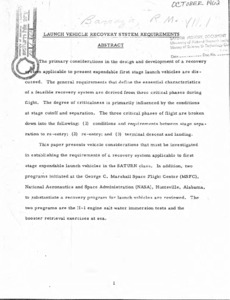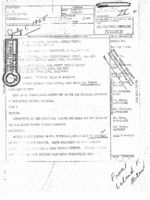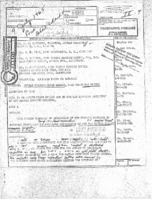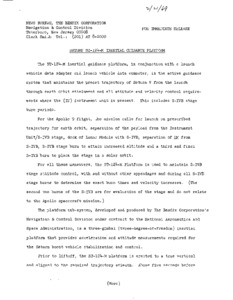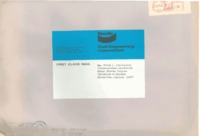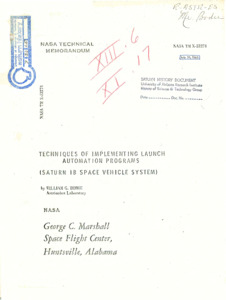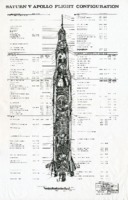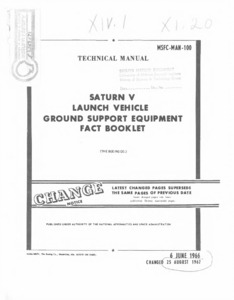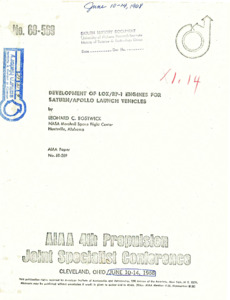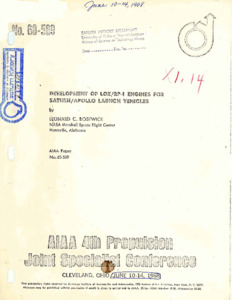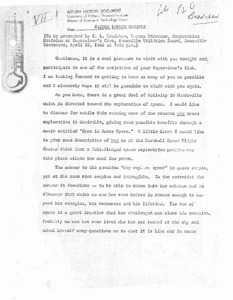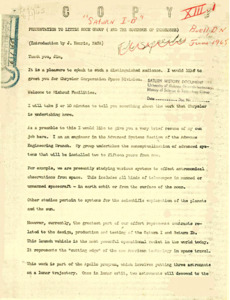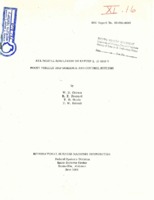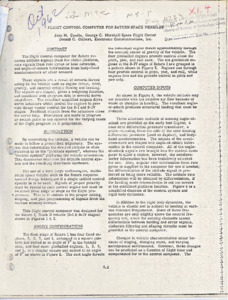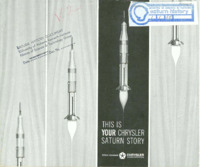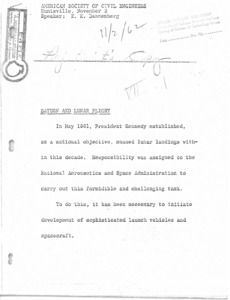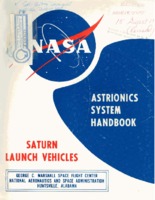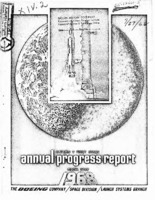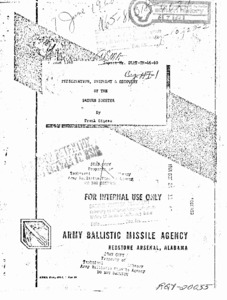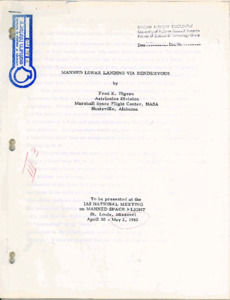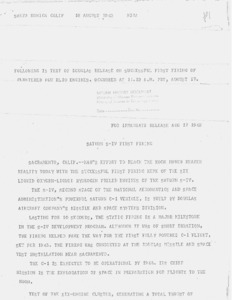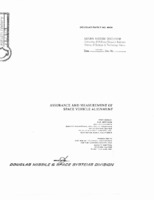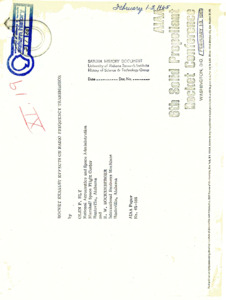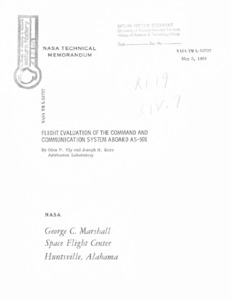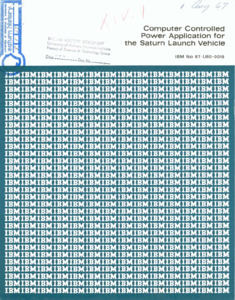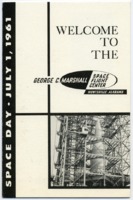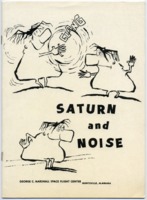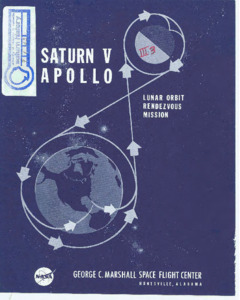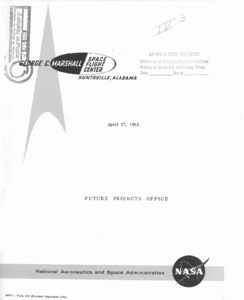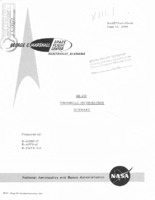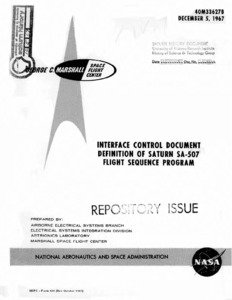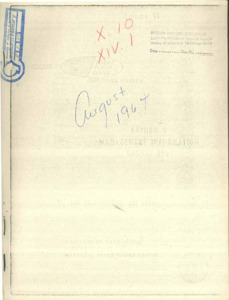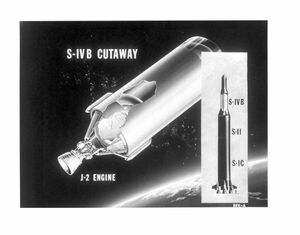
Browse Items (175 total)
Sort by:
-
"Launch Vehicle Recovery System Requirements."
The primary considerations in the design and development of a recovery system applicable to present expendable first stage launch vehicles are discussed. The general requirements that define the essential characteristics of a feasible recovery system are derived from three critical phases during flight. The degree of criticalness is primarily influenced by the conditions at stage cutoff and separation. The three critical phses of flight are broken down into the following: (1) conditions and requirements between stage separation to re-entry; (2) re-entry; and (3) terminal descent and landing. -
"Vibration and acoustic environment characteristics of the Saturn V launch vehicle."
This paper presents representative examples of vibration and acoustic data from flights of the Saturn V launch vehicle and static firings of Saturn V launch vehicle stages. The purpose of the paper is to provide vibration and acoustic environment characteristics which are pertinent to the design of launch vehicles -
Telegraphic message containing an Apollo Program Flash Report.
This message for the Apollo Program Director contains a report of the Apollo launch vehicles, problem that occurred, and actions required. The photocopy is difficult to read. -
Telegraphic message containing an Apollo Program Flash Report.
This message for the Apollo Program Director contains a report of the Apollo launch vehicles, problem that occurred, and actions required. The photocopy is difficult to read. -
"Saturn ST-124-M inertial guidance platform."
a press release which focuses around the Apollo 9 flight and what role the ST-124-M inertial guidance platform has in it. -
"Techniques of implementing launch automation programs" (Saturn IB space vehicle system).
This paper identifies the methods and equipment through which automation is becoming a major factor in testing and launching Saturn IB space vehicles. The merits of a digital guidance computer and its impact in extending automated checkout are stressed; also a logical basis is established for computer and manual test control. Hardware and software elements of the automated system are described, and details pertaining to reliability are emphasized. A concluding appraisal suggests that automation will play an expanding role in future test and launch operations. -
"Saturn V Apollo Flight Configuration."
Drawn by Don Sprague at the Huntsville Engineering section of Boeing. -
"Saturn V first stage annual progress report : fiscal year 1966."
This report is the consolidation of D5-11994, "Quarterly Technical Progress Report," for the fourth fiscal quarter and the fiscal year 1966 Annual Progress Report and places special emphasis on activities on the fourth fiscal quarter. -
"Saturn V launch vehicle ground support equipment fact booklet."
This booklet has been prepared to provide a quick reference to Saturn V stage peculiar ground support equipment. It consists of visual presentations and a brief description of each major component. It is intended to quickly familiarize concerned elements with the over-all MSFC launch vehicle ground support equipment and is not intended for design usage. The booklet has been prepared in five sections. Section I contains the introductory material and a description of the Saturn V mobile launcher (ML). Section II contains information on the umbilical equipment. Section III contains information on the servicing equipment, both fixed and mobile. Section IV contains information on the access equipment. Section V contains information on the handling and auxiliary equipment. -
"Development of LOX/RP-1 Engines for Saturn/Apollo Launch Vehicles."
The development of liquid rocket engines follow similar patterns regardless of engine size. During the development of the H-1 and F-1 engines, many problems were encountered. Methods of solving the combustion instability problem are discussed. A description is given of the major components of each engine, outlining their unique features. The requirements for an insulation cocoon are discussed. Problems associated with materials substitution are provided; also highlighted is the fact that problems occur after engine deliveries and require continued development support. Safety features incorporated on the engines are mentioned. Solution to problems encountered in flight are discussed. Upratings of both engines systems are presented graphically.; On the NASA Technical Reports Server (NTRS) unclassified. Can also be found on AIAA. -
Development of LOX/RP-1 engines for Saturn/Apollo launch vehicles.
The development of liquid rocket engines follow similar patterns regardless of engine size. During the development of the H-1 and F-1 engines, may problems were encountered. Mehtods of solving the combustion instability problem are discussed.; AIAA 4th Propulsion Joint Specialist Conference, Cleveland, Ohio, June 10-14, 1968.; Also available on NASA Technical Reports Server (NTRS) as unclassified. Can be ordered. Also on AIAA. -
"Saturn launch vehicle presentation."
Speech to be presented by C. L. Bradshaw, Deputy Director, Computation Division at Supervisor's Club, Knoxville Utilities Board. Speech praising the progress of space-based technologies and advancements. -
"Saturn IB : presentation to Little Rock Group."
Speech by H.D. Lowrey, SAE Meeting, Detroit, Michigan. Focuses on the Apollo project, the technology involved and what the goals of the project are. -
"All Digital Simulation of Saturn I, IB, and V: Boost Vehicle and Guidance Control Systems."
The introduction notes, "The Saturn V launch vehicle is being developed by the National Aeronautics and Space Administration's George C. Marshall Space Flight Center for Project Apollo; Saturn I and Saturn IB vehicles are providing the early testing and support for Project Apollo. The nerve center of the Saturn is its guidance and control system. An airborne digital computer provides the link which closes both the guidance and control loops,making verification of the flight computer program of vital importance. During a powered flight this onboard digital computer program can be divided into four major parts:a) guidance, including navigation, b) control, c) vehicle sequencing, and d) computer telemetry." -
"Flight Control Computer for Saturn Space Vehicles."
The flight control computer for Saturn receives attitude signals from the stable platform, rate signals from rate gyros or lead networks, and angle-of-attack information from body-fixed accelerometers or other sensors. -
"This is Your Chrysler Saturn Story."
The document is a booklet created as part of the NASA/Chrysler Corporation Space Division manned flight awareness program. It discusses Chrysler's role in manufacturing and testing the Saturn and includes photographs and diagrams of Saturn stages, operations at Michoud, testing, and future missions. The section headings included in this booklet are "Chrysler and the Saturn," "Saturn at Michoud," "The Voyage of Saturn," "Saturn Firings," and "Saturn's Missions." -
Saturn and lunar flight.
Speech by K.K. Dannenberg at American Society of Civil Engineers, Huntsville, November 2.; Projectionist's copy (photocopy) - slide numbers are included. -
"The significance of parameters affecting the heat transfer to the liquid hydrogen in the Saturn S-IVB stage for the lunar orbit rendezvous mission."
The Saturn S-IVB stage has a requirement for orbiting around the earth for up to 4.5 hours with approximately 60 percent of its initial propellant remaining at the end of the coast (prior to restart) . Extensive analyses must be performed to insure that this requirement is met. Both the maximum and minimum heat transfer rates are important because the maximum rates affect the hydrogen boiloff losses and thus the initial propellant loading requirements. The minimum rates are important because the boil off gases are used to maintain a minimum axial thrust level by venting the gases continuously through aft facing nozzles. This provides for a settling of the propellant throughout the orbital coast and alleviates the need for periodically venting the tank under zero gravity. -
Saturn Launch Vehicles Astrionics System Handbook, 2nd revised edition.
This updated edition of the Astrionics System Handbook instructs, "The enclosed pages change, delete, or supplement the information in the Astrionics System Handbook (1 August 1965). Insert these pages and destroy the pages they replace." -
Saturn Launch Vehicles Astrionics System Handbook.
Includes change pages. Contract NAS8-14000. Second revised edition. V66-15610. NASA-CR71607. The introduction notes, "This second revised edition of the Astrionics System Handbook has been developed under the direction and overall supervision of Dr. Rudolf Decher of the Astrionics Systems Engineering Office. This description of the Saturn Astrionics System has been generated by personnel of the Astrionics Laboratory, the staff of the Astrionics Systems Engineering Office, and by personnel of the International Business Machines Corporation working under Contract NAS8- 14000. The handbook will be updated and expanded as it becomes necessary due to changes or refinements in the system concept and hardware. Sections not contained in the first release of this document will be made available within three months." Signed by Ludie G. Richard, Chief, Systems Engineering Office, Astrionics Laboratory. The document is missing pages in the following locations: Chapters 8, 9, 12. Sections 15.2, 15.3, 15.4-1 thru 15.4-16, 15.5-1 thru 15.5-2, 15.5-5 thru 15.5-8. -
"Saturn V First Stage Annual Progress Report: Fiscal Year 1968."
The report covers June 30, 1967 through June 27, 1968: Contract NAS8-5608, Schedules 1 and 1A, July 27, 1968. Prepared by J. P. Delaloye, Management Reporting and Analysis; Supervised by D. G. Valentine, Management Reporting and Analysis; Approved by R. F. Terry, Program Reports; D. H. Creim, Michoud, Program Planning and Reporting Manager; E. K. Cooper, S-IC Program Executive. -
Preservation, shipment & recovery of the Saturn booster.
The purpose of this report is to present the shipping and recovery procedures for the Saturn booster. -
"Manned Lunar Landing via Rendezvous."
Paper to be presented at the IAS National Meeting on Manned Space Flight. Focuses on operations leading to injection of the space craft into the lunar transfer trajectory. -
"Saturn S-IV first firing."
Press release detailing the firing of the Saturn S-IV in California. -
"Assurance and Measurement of Space Vehicle Alignment."
Prepared by A. W. Dryden, Quality Engineer, Quality Engineering, Reliability Assurance, Space Systems Center, Douglas Aircraft Company, Inc., Huntington Beach, California. Presented to the 21st Annual Technical Conference for the American Society for Quality Control, Chicago, Illinois. 30 May to 2 June 1967. -
"Saturn Radar Altimeter."
Paper given at the AIAA Guidance and Control Conference, August 12-14, 1963, Massachusetts Institute of Technology, Cambridge, Massachusetts. -
"Rocket exhaust effects on radio frequency transmission."
Presented by Olen P. Ely, National Aeronautics and Space Administration, Marshall Space Flight Center, Huntsville, Alabama and R. W. Hockenberger, International Business Machines. Paper that explores the effects of rocket-engine exhaust on radio-signals. -
"Flight Evaluation of the Command and Communication System Aboard AS-501."
The first test of the command and communications system, a unified frequency S-band system, aboard AS-501 was successful. Compatibility of this system with the MSFN/USB sites was established. The onboard transponder and antenna system including antenna switching performed as predicted. The command performance was excellent with 5747 valid commands received onboard out of 5748 commands transmitted. Data reduction problems prevented a complete analysis of the tracking data. Telemetry system performance was satisfactory with a measured bit-error-rate of 4 x10-5 while over the Ascension Island station. This flight provided valuable data which can be used to define vehicle to-ground-station interfaces, to establish attitude constraints during translunar injection, and to improve operational procedures. One more test as successful as the AS-501 test would qualify the system as operational.; May 3,1968. -
"Computer Controlled Power Application for the Saturn Launch Vehicle".
This paper describes a real-time digital computer program that controls the application of electrical power to the S-IVB stage of the Saturn vehicle at Cape Kennedy, Florida. Douglas Aircraft Company, the S-IVB stage manufacturer, provided NASA with the program requirements relative to the energizing sequence, voltage and current measurement tolerances, and vehicle system operational tests. International Business Machines Corporation provided NASA with the computer program to satisfy the task requirements. The program conjoined the components of the Electrical Support Equipment (two RCA 110A computers and control and instrumentation devices) into a closed loop system. The supporting operating system program by IBM is described. -
Marshall Space Flight Center Space Day 1961 program.
The program includes "Marshall Center Highlights" from the Center's first year, a message from director Wernher von Braun, a photograph of the Space Queen and Princesses, and a guide to the Center's buildings. -
"Saturn and Noise."
The pamphlet uses a cartoon character named "D. B. Noyes" to explain to the public "the nature and effects of the noise which Saturn makes during static firing tests." -
"Saturn V Apollo lunar orbit rendezvous mission."
Diagram explaining the process of a lunar mission from liftoff to recovery. -
"Future Projects Office."
The purpose of this brochure is to give interested readers, outside as well as within the agencies of the U.S. Government, information on the mission and activities of the Future Projects Office, George C. Marshall Space. -
"AS-203 Technical Information Summary."
"This report outlines, through a series of sketches with accompanying text, the general features of the SA-203 Launch Vehicle and information on launch preparation, the launch facility and mission peculiar experiments." -
"Saturn V America's moon rocket."
Diagram that displays the Saturn V rocket with a page beneath detailing the function of each stage. -
"Interface Control Document Definition of Saturn SA-507 Flight Sequence Program."
The purpose of this document is to define the flight sequence events, time bases, stage switch selector channel assignments, LVDA Discrete Outputs, Inputs and Interrupts for the Saturn SA-507 & Subs vehicles. Special requirements and restrictions defined in this document will be imposed on the Marshall Space Flight Center and its contractors as applicable, to insure the proper functioning of the equipment in the various stages for required vehicle timing and sequencing to occur as outlined in this Interface Control Document (ICD). -
Saturn V management information : August 1964 : Volume VI.
This document contains copies of management charts maintained in the Managerial Data Center of the executive Staff on the Saturn V project. To facilitate use of this document, all Saturn V classified data has been removed and will be published in Volume XI. A list of these charts are shown on the "Table of Contents". Information on other MSFC activities will be published in separate volumes as indicated on the "Schedule for Publication of Data Bank Charts" contained in this volume. -
S-IVB cutaway and J-2 engine."
8 x 10 inch black and white diagram of the JII engine and the Saturn IV.
